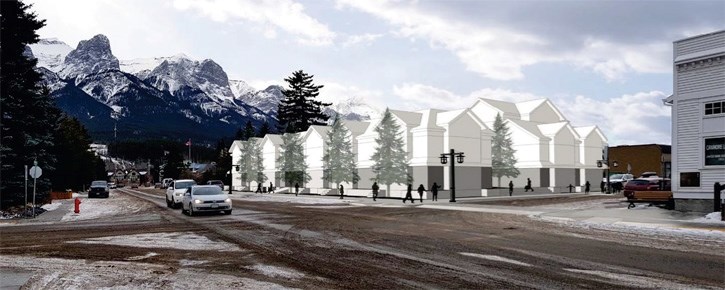The zoning change needed for a new medium density development in Canmore’s downtown core that includes affordable housing was passed by council, although not unanimously, on Tuesday (June 7).
Council voted to support a direct control district proposed by Distinctive Homes, a Canmore-based company, which would allow the developer to build a multi-family project on the site with the likelihood that 10 per cent of the units would be created as, and contribute toward, Canmore Community Housing Corporation’s perpetually affordable housing program.
Councillor Ed Russell was the sole voice of dissent in the vote, questioning whether several aspects of the application are appropriate – including a change from what would be currently permitted on the lots at Seventh Avenue and Seventh Street.
Russell said he would prefer to see the lots – four of them where the Sacred Heart Catholic Church is currently located – developed under the zoning in place in the 2012 Land Use Bylaw, which would allow fourplex style homes.
“I like the original bylaw,” he said. “I would rather see us go with something under that bylaw. We put lots of time and effort into developing (the Land Use Bylaw) and have it nice and simple.”
Russell implied that the direct control district, which would go in front of the Canmore Planning Commission for approval, is too important a decision to be left to that quasi-judicial council appointed committee.
“I have trouble with taking a decision of this magnitude to a group down the road and we don’t know who they will be,” he said. “People are hung up on density, but I think the collateral damage could be a parking problem.”
Mayor John Borrowman defended the qualifications and ability of the planning commission to handle development applications, including one for the location at Seventh and Seventh.
“I do not think this site zoning results in a project that would be outside the capability of the planning commission to consider,” Borrowman.
The mayor supported the rezoning application with changes made by administration, noting that increasing density in the downtown core fits the intention of the downtown enhancement plan by increasing vibrancy in the commercial area with more residents.
“I do, at least, hear regularly from residents of Canmore bemoaning the fact that shops on Main Street do not stay open late,” Borrowman said. “By encouraging more residential density within an easy walk to downtown, hopefully we are adding vibrancy to our downtown core.”
The rest of council was supportive of the direct control zoning, and changes brought forward by administration to the district as a result of what was heard at a public hearing in April.
Planner Marcus Henry went through the changes, including one that requires all parking to be provided on site. At first reading, the district proposed to consider on-street parking as visitor parking for the development, a change from previous approvals for multi-family residential projects.
Henry said administration changed the district to require all parking be provided onsite, to address that concern. There was also concern expressed, he noted, around building height, public realm enhancements, parkade construction and lack of commercial uses.
Changes include removing the ability to apply variances to building height, as well as an added requirement to add street enhancements for the public realm.
Coun. Sean Krausert noted the application for zoning does not address specific issues related to an actual proposed development because those are factors taken into consideration specifically at the development permit stage.
“I really appreciate how this has taken a creative approach to increase density on a site while not adversely affecting the visual impact; this has very similar massing to what is already allowed,” Krausert said. “At the development permit stage thought will be given to various requirements like parking.”
There were concerns around the legality of requiring perpetually affordable housing in the land use zoning, but Krausert proposed wording that allowed the bylaw to retain a clause addressing how it would be provided.
Currently, said Henry, the developer is prepared to enter into a memorandum of understanding that sets out a commitment to providing PAH that would see 10 per cent of the total units provided at below market prices through CCHC.




